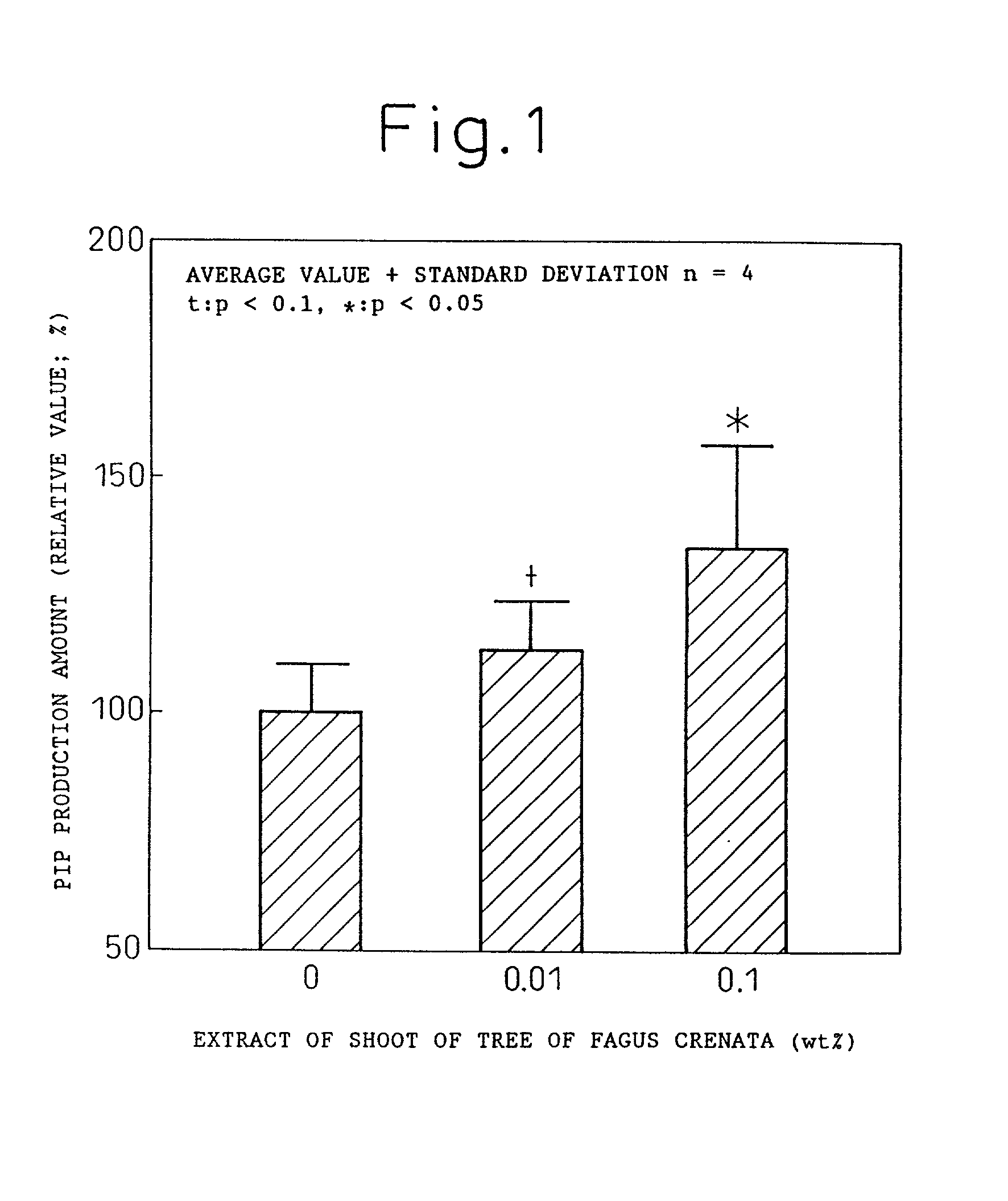Collagen production promoter composition
a technology of promoter composition and collagen, which is applied in the direction of biocide, plant/algae/fungi/lichens, drug compositions, etc., can solve the problems of insufficient prevention of aging of the skin, loss of tautness and gloss, and changes in appearance of many middle-aged and elderly people in the world, particularly women
- Summary
- Abstract
- Description
- Claims
- Application Information
AI Technical Summary
Benefits of technology
Problems solved by technology
Method used
Image
Examples
example 2
Cream
[0075]
3 Formulation wt % Stearic acid 2.0 Stearyl alcohol 7.0 Hydrogenated lanolin 2.0 Squalane 5.0 2-octyldodecyl alcohol 6.0 Polyoxyethylene (25 mol) cetyl alcohol ether 3.0 Glyceryl monostearate ester 2.0 Propylene glycol 5.0 Ethanol extract containing shoot of Fagus crenata 5.0 Tranexamic acid 0.2 Ethylparaben 0.3 Perfume q.s. Ion exchange water Bal.
Process of Production
[0076] The propylene glycol was added to the ion exchange water, then the mixture was heated and held at 70.degree. C. (aqueous phase). The other ingredients were mixed and heated to melt, then the resultant mixture was held at 70.degree. C. (oil phase). The oil phase was added to the aqueous phase and preliminarily emulsified and then emulsified uniformly by a homomixer, then the resultant mixture was rapidly cooled to 30.degree. C. while stirring well.
example 3
Cream
[0077]
4 Formulation wt % Solid paraffin 5.0 Beeswax 10.0 Vaseline 15.0 Liquid paraffin 41.0 Glyceryl monostearate ester 2.0 Polyoxyethylene (20 mol) 2.0 sorbitan monolaurate ester Soap powder 0.1 Acetone extract of young shoot 0.05 of Fagus crenata Sodium bisulfite 0.03 Ethylparaben 0.3 Perfume q.s. Ion exchange water Bal.
Process of Production
[0078] The soap powder was added to the ion exchange water and heated and held at 70.degree. C. (aqueous phase). The other ingredients were mixed and heated to melt, then held at 70.degree. C. (oil phase). The oil phase was gradually added to the aqueous phase while stirring for the reaction. After the end of the reaction, the resultant mixture was uniformly emulsified by a homomixer. After the emulsification, the resultant mixture was cooled to 30.degree. C. while stirring.
example 4
[0079]
5 Formulation wt % Stearic acid 2.5 Cetyl alcohol 1.5 Vaseline 5.0 Liquid paraffin 10.0 Polyoxyethylene (10 mol) 2.0 monooleate ester Polyethylene glycol 1500 3.0 Triethanolamine 1.0 Carboxyvinyl polymer (brandname: Carbopol 0.05 941, B. F. Goodrich Chemical Co.) GATULINE (registered trademark) .RTM. 0.01 Sodium bisulfite 0.01 Ethylparaben 0.3 Perfume q.s. Ion exchange water Bal.
Process of Production
[0080] The carboxyvinyl polymer was dissolved in a small amount of ion exchange water (phase A). Polyethylene glycol 1500 and triethanolamine were added to the remaining ion exchange water, heated to melt, and held at 70.degree. C. (aqueous phase). The rest of the ingredients were mixed and heated to melt, then held at 70.degree. C. (oil phase). The oil phase was added to the aqueous phase and preliminarily emulsified, then the phase A was added and the mixture homogeneously emulsified by a homomixer. After the emulsification, the resultant mixture was cooled to 30.degree. ...
PUM
 Login to View More
Login to View More Abstract
Description
Claims
Application Information
 Login to View More
Login to View More - R&D
- Intellectual Property
- Life Sciences
- Materials
- Tech Scout
- Unparalleled Data Quality
- Higher Quality Content
- 60% Fewer Hallucinations
Browse by: Latest US Patents, China's latest patents, Technical Efficacy Thesaurus, Application Domain, Technology Topic, Popular Technical Reports.
© 2025 PatSnap. All rights reserved.Legal|Privacy policy|Modern Slavery Act Transparency Statement|Sitemap|About US| Contact US: help@patsnap.com

